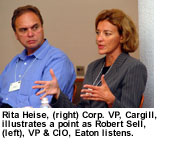
|
|
|
 |
|
 |
Enabling a Customer-Focused Organization
Thought Leadership Summit on Digital Strategies September 9, 2003 - South Bend, IN hosted by Whirlpool Corporation What does it mean to be customer focused? How do you engender customer-centricity in a corporation? |
||
|
Press Release
Agenda
List of participants
Discussion Guide
Overview article
|
|||||
Understanding what it means to have a customer-focused organization and how to enable that focus was the topic of the fifth Thought Leadership Summit on Digital Strategies, hosted by Whirlpool Corporation in South Bend, IN. CIOs and other senior executives from a number of Fortune 250 companies including Cargill, Cisco Systems, Colgate Palmolive, Eaton, Hewlett-Packard, Lowe's, Owens Corning, Staples, and Whirlpool participated in this roundtable forum, together with a select group of senior academics specializing in the subject matter. Rich Karlgaard, publisher of Forbes, was the moderator and together with his co-moderator, John Marshall of Digitas, wrapped up a successful and interesting day of dialogue.
Much of the discussion revolved around how to create the right environment for fostering customer-centricity. Here are some key learnings from the summit that CIOs and senior executives should keep in mind as they address customer-focus in their own organizations:
- Having a transactional view of the customer is not enough - organizations must develop the capability to see the customer as a whole, understanding the complete customer lifecycle, with a firm grasp on the actual and potential touch points.
- In-depth human insights into customer systems are as important as hard customer data - in fact, they are essential to making sense of the large amounts of quantitative data.
- Customer focus requires a bias for action: quick process wins, customer responsiveness and executive engagement all rooted in clear understanding of the business and the customer at each level.
- Customer centricity must become part of the DNA of a company, communicated through the vision and passion of the leadership and imbued in the incentives and metrics of each employee - it can't be just another program.
- Value-chain interactions should be examined through the eyes of the end-customer - this is the point of unification and the driver of sustainable (profitable) customer-centricity for all points in the chain.
![]()
| To link to the Thought Leadership Summit on Digital Strategies website, click here. |